Antioxidant, Antimicrobial, and Insecticidal Properties of Chemically Characterized Essential Oils Extracted from Mentha longifolia: In Vitro and In Silico Analysis
Abstract
:1. Introduction
2. Results and Discussion
2.1. Volatile Profile of Essential Oil
2.2. Antioxidant Activity
2.3. Antibacterial Activities of M. longifolia Essential Oil
2.4. Antifungal Activities of M. longifolia Essential Oil
2.5. Insecticidal Activity
2.6. Fumigation Bioassay
2.6.1. Effect of ML-EO on Adult Mortality
2.6.2. Effect of ML-EO on Fecundity
2.6.3. Effect on Fertility
2.6.4. Effect on Adult Emergence
2.6.5. Repellency Test
2.7. Molecular Docking
2.8. Statistical Analysis
Principal Component Analysis
3. Material and Methods
3.1. Collection of Plant Materials
3.1.1. Extraction of the Volatile Oils
3.1.2. Chemical Characterization of Essential Oil by GC/MS/MS
3.2. Antioxidant Ability of Essential Oil
3.2.1. DPPH Scavenging Capacity
3.2.2. Radical Cation Decolorization (ABTS Assay)
3.2.3. Reducing Power (RP)
3.2.4. Total Antioxidant Activity (TAC)
3.3. Antimicrobial Activities of Essential Oil
3.3.1. Assessment Procedure of the Antimicrobial Capacity
3.3.2. Minimum Inhibitory Concentration (MIC)
3.4. Insecticidal Potential
3.4.1. Breeding of Insects
3.4.2. Toxicity of Essential Oils against Callosobruchus maculatus: Fumigation Test
3.4.3. Repellent Influence of Essential Oils
3.5. Molecular Docking
3.5.1. Ligand Preparation
3.5.2. Protein Preparation
3.6. Statistical Analysis
4. Conclusions
Author Contributions
Funding
Data Availability Statement
Conflicts of Interest
References
- Laranjo, M.; Fernández-León, A.M.; Agulheiro-Santos, A.C.; Potes, M.E.; Elias, M. Essential Oils of Aromatic and Medicinal Plants Play a Role in Food Safety. J. Food Process. Preserv. 2022, 46, e14278. [Google Scholar] [CrossRef]
- Swamy, M.K.; Sinniah, U.R. A Comprehensive Review on the Phytochemical Constituents and Pharmacological Activities of Pogostemon Cablin Benth.: An Aromatic Medicinal Plant of Industrial Importance. Molecules 2015, 20, 8521–8547. [Google Scholar] [CrossRef]
- Laranjo, M.; Fernández-León, A.M.; Potes, M.E.; Agulheiro-Santos, A.; Elias, M. Use of Essential Oils in Food Preservation. 2017. Available online: https://api.semanticscholar.org/CorpusID:96440310 (accessed on 29 January 2023).
- Dorman, H.J.D.; Koşar, M.; Kahlos, K.; Holm, Y.; Hiltunen, R. Antioxidant Properties and Composition of Aqueous Extracts from Mentha Species, Hybrids, Varieties, and Cultivars. J. Agric. Food Chem. 2003, 51, 4563–4569. [Google Scholar] [CrossRef] [PubMed]
- Özdemir, E.; Alpınar, K. An Ethnobotanical Survey of Medicinal Plants in Western Part of Central Taurus Mountains: Aladaglar (Nigde—Turkey). J. Ethnopharmacol. 2015, 166, 53–65. [Google Scholar] [CrossRef] [PubMed]
- Tuzlaci, E. Turkish Folk Medicinal Plants, IX: Ovacik (Tunceli). Marmara Pharm. J. 2010, 3, 136–143. [Google Scholar] [CrossRef]
- Mokaberinejad, R.; Akhtari, E.; Tansaz, M.; Bioos, S.; Kamalinejad, M.; Zafarghandi, N.; Ghobadi, A.; Sohrabvand, F.; Akhbari, A. Effect of Mentha longifolia on FSH Serum Level in Premature Ovarian Failure. Open J. Obstet. Gynecol. 2014, 4, 356–360. [Google Scholar] [CrossRef]
- Salehi, B.; Stojanović-Radić, Z.; Matejić, J.; Sharopov, F.; Antolak, H.; Kręgiel, D.; Sen, S.; Sharifi-Rad, M.; Acharya, K.; Sharifi-Rad, R.; et al. Plants of Genus Mentha: From Farm to Food Factory. Plants 2018, 7, 70. [Google Scholar] [CrossRef]
- Farzaei, M.H.; Bahramsoltani, R.; Ghobadi, A.; Farzaei, F.; Najafi, F. Pharmacological Activity of Mentha longifolia and Its Phytoconstituents. J. Tradit. Chin. Med. 2017, 37, 710–720. [Google Scholar] [CrossRef]
- Rahimi, A.R.; Mousavizadeh, S.J.; Mohammadi, H.; Majidi, M.; Amini, S. Allelopathic Effect of Some Essential Oils on Seed Germination of Lathyrus Annuus and Vicia Villosa. J. Biodivers. Environ. Sci. 2013, 3, 67–73. [Google Scholar]
- Džamić, A.M.; Soković, M.D.; Ristić, M.S.; Novaković, M.; Grujić-Jovanović, S.; Tešević, V.; Marin, P.D. Antifungal and Antioxidant Activity of Mentha Longifolia (L.) Hudson (Lamiaceae) Essential Oil. Bot. Serb. 2010, 34, 5. [Google Scholar]
- Qanash, H.; Bazaid, A.S.; Binsaleh, N.K.; Alharbi, B.; Alshammari, N.; Qahl, S.H.; Alhuthali, H.M.; Bagher, A.A. Phytochemical Characterization of Saudi Mint and Its Mediating Effect on the Production of Silver Nanoparticles and Its Antimicrobial and Antioxidant Activities. Plants 2023, 12, 2177. [Google Scholar] [CrossRef] [PubMed]
- Ghoulami, S. Phytochemical Study of Mentha longifolia of Morocco. Fitoterapia 2001, 72, 596–598. [Google Scholar] [CrossRef] [PubMed]
- De Sousa Barros, A.; de Morais, S.M.; Ferreira, P.A.T.; Vieira, Í.G.P.; Craveiro, A.A.; dos Santos Fontenelle, R.O.; de Menezes, J.E.S.A.; da Silva, F.W.F.; de Sousa, H.A. Chemical Composition and Functional Properties of Essential Oils from Mentha Species. Ind. Crops Prod. 2015, 76, 557–564. [Google Scholar] [CrossRef]
- Singh, H.P.; Batish, D.R.; Mittal, S.; Dogra, K.S.; Yadav, S.; Kohli, R.K. Constituents of Leaf Essential Oil of Mentha longifolia from India. Chem. Nat. Compd. 2008, 44, 528–529. [Google Scholar] [CrossRef]
- Boira, H.; Blanquer, A. Environmental Factors Affecting Chemical Variability of Essential Oils in 1hymus Piperella L. Biochem. Syst. Ecol. 1998, 26, 811–822. [Google Scholar] [CrossRef]
- Zouari-Bouassida, K.; Trigui, M.; Makni, S.; Jlaiel, L.; Tounsi, S. Seasonal Variation in Essential Oils Composition and the Biological and Pharmaceutical Protective Effects of Mentha longifolia Leaves Grown in Tunisia. BioMed Res. Int. 2018, 2018, 1–12. [Google Scholar] [CrossRef] [PubMed]
- Mimica-Dukic, N.; Božin, B.; Soković, M.; Mihajlović, B.; Matavulj, M. Antimicrobial and Antioxidant Activities of Three Mentha Species Essential Oils. Planta Med. 2003, 69, 413–419. [Google Scholar] [CrossRef]
- Anwar, F.; Alkharfy, K.M.; Rehman, N.U.; Adam, E.; Gilani, A. Chemo-Geographical Variations in the Composition of Volatiles and the Biological Attributes of Mentha longifolia (L.) Essential Oils from Saudi Arabia. Int. J. Pharmacol. 2017, 13, 408–424. [Google Scholar] [CrossRef]
- Bardaweel, S.K.; Bakchiche, B.; ALSalamat, H.A.; Rezzoug, M.; Gherib, A.; Flamini, G. Chemical Composition, Antioxidant, Antimicrobial and Antiproliferative Activities of Essential Oil of Mentha Spicata L. (Lamiaceae) from Algerian Saharan Atlas. BMC Complement. Altern. Med. 2018, 18, 201. [Google Scholar] [CrossRef]
- Salamatullah, A.M. Identification of Volatile Compounds and Antioxidant, Antibacterial, and Antifungal Properties against Drug-Resistant Microbes of Essential Oils from the Leaves of Mentha rotundifolia Var. Apodysa Briq. (Lamiaceae). Open Chem. 2022, 20, 484–493. [Google Scholar] [CrossRef]
- Oyedeji, A.O.; Afolayan, A.J. Chemical Composition and Antibacterial Activity of the Essential Oil Isolated from South African Mentha longifolia (L.) L. Subsp. Capensis (Thunb.) Briq. J. Essent. Oil Res. 2006, 18, 57–59. [Google Scholar] [CrossRef]
- Sitzmann, J.; Habegger, R.; Schnitzler, W.H.; Grassmann, J. Comparative Analysis of Antioxidant Activities of Fourteen Mentha Essential Oils and Their Components. Chem. Biodivers. 2014, 11, 1978–1989. [Google Scholar] [CrossRef] [PubMed]
- Butler, M.S.; Blaskovich, M.A.; Cooper, M.A. Antibiotics in the Clinical Pipeline at the End of 2015. J. Antibiot. 2017, 70, 3–24. [Google Scholar] [CrossRef] [PubMed]
- Hajlaoui, H.; Snoussi, M.; Ben Jannet, H.; Mighri, Z.; Bakhrouf, A. Comparison of Chemical Composition and Antimicrobial Activities of Mentha longifolia L. ssp. longifolia Essential Oil from Two Tunisian Localities (Gabes and Sidi Bouzid). Ann. Microbiol. 2008, 58, 513–520. [Google Scholar] [CrossRef]
- Nikšić, H.; Bešović, E.K.; Makarević, E.; Durić, K. Chemical Composition, Antimicrobial and Antioxidant Properties of Mentha longifolia (L.) Huds. Essential Oil. J. Health Sci. 2012, 2, 192–200. [Google Scholar] [CrossRef]
- Gulluce, M.; Sahin, F.; Sokmen, M.; Ozer, H.; Daferera, D.; Sokmen, A.; Polissiou, M.; Adiguzel, A.; Ozkan, H. Antimicrobial and Antioxidant Properties of the Essential Oils and Methanol Extract from Mentha longifolia L. Ssp. Longifolia. Food Chem. 2007, 103, 1449–1456. [Google Scholar] [CrossRef]
- Nazzaro, F.; Fratianni, F.; De Martino, L.; Coppola, R.; De Feo, V. Effect of Essential Oils on Pathogenic Bacteria. Pharmaceuticals 2013, 6, 1451–1474. [Google Scholar] [CrossRef]
- Yuan, Y.; Liu, L.; Guo, L.; Wang, L.; Liu, Y. Antibacterial Mechanism of Rose Essential Oil against Pseudomonas putida Isolated from White Hypsizygus Marmoreus at Cellular and Metabolic Levels. Ind. Crops Prod. 2023, 196, 116523. [Google Scholar] [CrossRef]
- Lopez-Romero, J.C.; González-Ríos, H.; Borges, A.; Simões, M. Antibacterial Effects and Mode of Action of Selected Essential Oils Components against Escherichia coli and Staphylococcus aureus. Evid. Based Complement. Altern. Med. 2015, 2015, 1–9. [Google Scholar] [CrossRef]
- Sefu, G.; Satheesh, N.; Berecha, G. Antifungal Activity of Ginger and Cinnamon Leaf Essential Oils on Mango Anthracnose Disease Causing Fungi (C. gloeosporioides). Carpathian J. Food Sci. Technol. 2015, 7, 26–34. [Google Scholar]
- Di Sotto, A.; Di Giacomo, S.; Abete, L.; Božović, M.; Parisi, O.A.; Barile, F.; Vitalone, A.; Izzo, A.A.; Ragno, R.; Mazzanti, G. Genotoxicity Assessment of Piperitenone Oxide: An in Vitro and in Silico Evaluation. Food Chem. Toxicol. 2017, 106, 506–513. [Google Scholar] [CrossRef]
- Zengin, H.; Baysal, A. Antibacterial and Antioxidant Activity of Essential Oil Terpenes against Pathogenic and Spoilage-Forming Bacteria and Cell Structure-Activity Relationships Evaluated by SEM Microscopy. Molecules 2014, 19, 17773–17798. [Google Scholar] [CrossRef] [PubMed]
- Pfaller, M.A.; Diekema, D.J. Epidemiology of Invasive Candidiasis: A Persistent Public Health Problem. Clin. Microbiol. Rev. 2007, 20, 133–163. [Google Scholar] [CrossRef] [PubMed]
- Lugosi, M.; Alberti, C.; Zahar, J.-R.; Garrouste, M.; Lemiale, V.; Descorps-Desclère, A.; Ricard, J.-D.; Goldgran-Tolédano, D.; Cohen, Y.; Schwebel, C.; et al. Aspergillus in the Lower Respiratory Tract of Immunocompetent Critically Ill Patients. J. Infect. 2014, 69, 284–292. [Google Scholar] [CrossRef]
- Mkaddem, M.; Bouajila, J.; Ennajar, M.; Lebrihi, A.; Mathieu, F.; Romdhane, M. Chemical Composition and Antimicrobial and Antioxidant Activities of Mentha (Longifolia L. and viridis) Essential Oils. J. Food Sci. 2009, 74, M358–M363. [Google Scholar] [CrossRef]
- Ali, H.M.; Elgat, W.A.A.A.; EL-Hefny, M.; Salem, M.Z.M.; Taha, A.S.; Al Farraj, D.A.; Elshikh, M.S.; Hatamleh, A.A.; Abdel-Salam, E.M. New Approach for Using of Mentha longifolia L. and Citrus reticulata L. Essential Oils as Wood-Biofungicides: GC-MS, SEM, and MNDO Quantum Chemical Studies. Materials 2021, 14, 1361. [Google Scholar] [CrossRef] [PubMed]
- Oumzil, H.; Ghoulami, S.; Rhajaoui, M.; Ilidrissi, A.; Fkih-Tetouani, S.; Faid, M.; Benjouad, A. Antibacterial and Antifungal Activity of Essential Oils of Mentha suaveolens. Phytother. Res. 2002, 16, 727–731. [Google Scholar] [CrossRef] [PubMed]
- Hyldgaard, M.; Mygind, T.; Meyer, R.L. Essential Oils in Food Preservation: Mode of Action, Synergies, and Interactions with Food Matrix Components. Front. Microbiol. 2012, 3, 12. [Google Scholar] [CrossRef] [PubMed]
- Bakkali, F.; Averbeck, S.; Averbeck, D.; Zhiri, A.; Idaomar, M. Cytotoxicity and Gene Induction by Some Essential Oils in the Yeast Saccharomyces cerevisiae. Mutat. Res. Genet. Toxicol. Environ. Mutagen. 2005, 585, 1–13. [Google Scholar] [CrossRef]
- Lopes, L.M.; Sousa, A.H.; Santos, V.B.; Silva, G.N.; Abreu, A.O. Development Rates of Callosobruchus maculatus (Coleoptera: Chrysomelidae) in Landrace Cowpea Varieties Occurring in Southwestern Amazonia. J. Stored Prod. Res. 2018, 76, 111–115. [Google Scholar] [CrossRef]
- Odeyemi, O.O.; Masika, P.; Afolayan, A.J. Insecticidal Activities of Essential Oil from the Leaves of Mentha longifolia L. Subsp. Capensis against Sitophilus zeamais (Motschulsky) (Coleoptera: Curculionidae). Afr. Entomol. 2008, 16, 220–225. [Google Scholar] [CrossRef]
- Khani, A.; Asghari, J. Insecticide Activity of Essential Oils of Mentha Longifolia, Pulicaria Gnaphalodes and Achillea Wilhelmsii Against Two Stored Product Pests, the Flour Beetle, Tribolium Castaneum, and the Cowpea Weevil, Callosobruchus maculatus. J. Insect Sci. 2012, 12, 73. [Google Scholar] [CrossRef] [PubMed]
- Kumar, P.; Mishra, S.; Malik, A.; Satya, S. Insecticidal Properties of Mentha Species: A Review. Ind. Crops Prod. 2011, 34, 802–817. [Google Scholar] [CrossRef]
- Hategekimana, A.; Erler, F. Fecundity and Fertility Inhibition Effects of Some Plant Essential Oils and Their Major Components against Acanthoscelides obtectus say (Coleoptera: Bruchidae). J. Plant Dis. Prot. 2020, 127, 615–623. [Google Scholar] [CrossRef]
- Regnault-Roger, C.; Hamraoui, A. Comparison of the Insecticidal Effects of Water Extracted and Intact Aromatic Plants on Acanthoscelides obtectus, a Bruchid Beetle Pest of Kidney Beans. Chemoecology 1994, 5–6, 1–5. [Google Scholar] [CrossRef]
- Aziz, E.E.; Abbass, M.H. Chemical Composition and Efficiency of Five Essential Oils against the Pulse Beetle Callosobruchus maculatus (F.) on Vigna Radiata Seeds. Am. Eurasian J. Agric. Environ. Sci. 2010, 8, 411–419. [Google Scholar]
- Saxena, B.P.; Mathur, A.C. Loss of Fecundity in Dysdercus Koenigii F. Due to Vapours of Acorus calamus L. Oil. Experientia 1976, 32, 315–316. [Google Scholar] [CrossRef]
- Williams, C.M. The Juvenile Hormone of Insects. Nature 1956, 178, 212–213. [Google Scholar] [CrossRef]
- Aimad, A.; Sanae, R.; Anas, F.; Abdelfattah, E.M.; Bourhia, M.; Salamatullah, A.M.; Alzahrani, A.; Alyahya, H.K.; Albadr, N.A.; Abdelkrim, A.; et al. Chemical Characterization and Antioxidant, Antimicrobial, and Insecticidal Properties of Essential Oil from Mentha pulegium L. Evid. Based Complement. Altern. Med. 2021, 2021, 1–12. [Google Scholar] [CrossRef]
- Pavela, R. History, Presence and Perspective of Using Plant Extracts as Commercial Botanical Insecticides and Farm Products for Protection against Insects—A Review. Plant Prot. Sci. 2016, 52, 229–241. [Google Scholar] [CrossRef]
- Ahn, Y.J.; Lee, S.B.; Lee, H.S.; Kim, G.H. Insecticidal and Acaricidal Activity of Carvacrol and Beta-Thujaplicine Derived from Thujopsis Dolabrata Var. Hondai Sawdust. J. Chem. Ecol. 1998, 24, 81–90. [Google Scholar] [CrossRef]
- Rattan, R.S. Mechanism of Action of Insecticidal Secondary Metabolites of Plant Origin. Crop Prot. 2010, 29, 913–920. [Google Scholar] [CrossRef]
- López, M.D.; Pascual-Villalobos, M.J. Mode of Inhibition of Acetylcholinesterase by Monoterpenoids and Implications for Pest Control. Ind. Crops Prod. 2010, 31, 284–288. [Google Scholar] [CrossRef]
- Price, D.N.; Berry, M.S. Comparison of Effects of Octopamine and Insecticidal Essential Oils on Activity in the Nerve Cord, Foregut, and Dorsal Unpaired Median Neurons of Cockroaches. J. Insect. Physiol. 2006, 52, 309–319. [Google Scholar] [CrossRef] [PubMed]
- Kavallieratos, N.G.; Nika, E.P.; Skourti, A.; Xefteri, D.N.; Cianfaglione, K.; Perinelli, D.R.; Spinozzi, E.; Bonacucina, G.; Canale, A.; Benelli, G.; et al. Piperitenone Oxide-Rich Mentha longifolia Essential Oil and Its Nanoemulsion to Manage Different Developmental Stages of Insect and Mite Pests Attacking Stored Wheat. Ind. Crops Prod. 2022, 178, 114600. [Google Scholar] [CrossRef]
- Miyazawa, M.; Watanabe, H.; Umemoto, K.; Kameoka, H. Inhibition of Acetylcholinesterase Activity by Essential Oils of Mentha Species. J. Agric. Food Chem. 1998, 46, 3431–3434. [Google Scholar] [CrossRef]
- Lee, S.-E.; Lee, B.-H.; Choi, W.-S.; Park, B.-S.; Kim, J.-G.; Campbell, B.C. Fumigant Toxicity of Volatile Natural Products from Korean Spices and Medicinal Plants towards the Rice Weevil, Sitophilus oryzae (L). Pest. Manag. Sci. 2001, 57, 548–553. [Google Scholar] [CrossRef] [PubMed]
- Enan, E. Insecticidal Activity of Essential Oils: Octopaminergic Sites of Action. Comp. Biochem. Physiol. Part C Toxicol. Pharmacol. 2001, 130, 325–337. [Google Scholar] [CrossRef]
- Barbieri, N.; Costamagna, M.; Gilabert, M.; Perotti, M.; Schuff, C.; Isla, M.I.; Benavente, A. Antioxidant Activity and Chemical Composition of Essential Oils of Three Aromatic Plants from La Rioja Province. Pharm. Biol. 2016, 54, 168–173. [Google Scholar] [CrossRef]
- Elzaawely, A.A.; Xuan, T.D.; Koyama, H.; Tawata, S. Antioxidant Activity and Contents of Essential Oil and Phenolic Compounds in Flowers and Seeds of Alpinia zerumbet (Pers.) B.L. Burtt. & R.M. Sm. Food Chem. 2007, 104, 1648–1653. [Google Scholar] [CrossRef]
- Karapandzova, M.; Stefkov, G.; Dokik, E.T.; Panovska, T.K.; Kaftandzieva, A.; Kulevanova, S. Chemical Characterization and Antimicrobial Activity of the Needle Essential Oil of Pinus mugo (Pinaceae) from Macedonian Flora. Planta Med. 2011, 77, PL59. [Google Scholar] [CrossRef]
- Šavikin, K.P.; Menković, N.R.; Zdunić, G.M.; Tasić, S.R.; Ristić, M.S.; Stević, T.R.; Dajić-Stevanović, Z.P. Chemical Composition and Antimicrobial Activity of the Essential Oils of Micromeria thymifolia (Scop.) Fritsch., M. Dalmatica Benth., and Satureja Cuneifolia Ten. and Its Secretory Elements. J. Essent. Oil Res. 2010, 22, 91–96. [Google Scholar] [CrossRef]
- Lafraxo, S.; El Moussaoui, A.; A Bin Jardan, Y.; El Barnossi, A.; Chebaibi, M.; Baammi, S.; Akka, A.A.; Chebbac, K.; Akhazzane, M.; Chelouati, T.; et al. GC-MS Profiling, In Vitro Antioxidant, Antimicrobial, and In Silico NADPH Oxidase Inhibition Studies of Essential Oil of Juniperus thurifera Bark. Evid. Based Complement. Altern. Med. 2022, 2022, 1–13. [Google Scholar] [CrossRef] [PubMed]
- Ben Arfa, A.; Gouja, H.; Hannachi, H.; Isoda, H.; Neffati, M.; Najjaa, H. Seasonal Changes in Rosemary Species: A Chemotaxonomic Assessment of Two Varieties Based on Essential Oil Compounds, Antioxidant and Antibacterial Activities. PLoS ONE 2022, 17, e0273367. [Google Scholar] [CrossRef] [PubMed]
- Epand, R.M.; Walker, C.; Epand, R.F.; Magarvey, N.A. Molecular Mechanisms of Membrane Targeting Antibiotics. Biochim. Biophys. Acta BBA Biomembr. 2016, 1858, 980–987. [Google Scholar] [CrossRef] [PubMed]
- Kosar, M.; Tunalier, Z.; Özek, T.; Kürkcüoglu, M.; Baser, K.H.C. A Simple Method to Obtain Essential Oils from Salvia Triloba L. and Laurus Nobilis L. by Using Microwave-Assisted Hydrodistillation. Z. Naturforschung C 2005, 60, 501–504. [Google Scholar] [CrossRef]
- Adams, R.P. Identification of Essential Oil Components by Gas Chromatography/Mass Spectrometry. Identif. Essent. Oil Compon. Gas Chromatogr. Mass Spectrom. 2007, 24, 245–251. [Google Scholar]
- Burits, M.; Bucar, F. Antioxidant Activity of Nigella sativa Essential Oil. Phytother Res 2000, 14, 323–328. [Google Scholar] [CrossRef]
- Re, R.; Pellegrini, N.; Proteggente, A.; Pannala, A.; Yang, M.; Rice-Evans, C. Antioxidant Activity Applying an Improved ABTS Radical Cation Decolorization Assay. Free. Radic. Biol. Med. 1999, 26, 1231–1237. [Google Scholar] [CrossRef]
- Parki, A.; Chaubey, P.; Prakash, O.; Kumar, R.; Pant, A.K. Seasonal Variation in Essential Oil Compositions and Antioxidant Properties of Acorus calamus L. Accessions. Medicines 2017, 4, 81. [Google Scholar] [CrossRef]
- Prieto, P.; Pineda, M.; Aguilar, M. Spectrophotometric Quantitation of Antioxidant Capacity through the Formation of a Phosphomolybdenum Complex: Specific Application to the Determination of Vitamin E. Anal. Biochem. 1999, 269, 337–341. [Google Scholar] [CrossRef] [PubMed]
- Bauer, A.W.; Kirby, W.M.; Sherris, J.C.; Turck, M. Antibiotic Susceptibility Testing by a Standardized Single Disk Method. Am. J. Clin. Pathol. 1966, 45, 493–496. [Google Scholar] [CrossRef]
- M100Ed32; Performance Standards for Antimicrobial Susceptibility Testing, 32nd ed. Available online: https://clsi.org/standards/products/microbiology/documents/m100/ (accessed on 29 January 2023).
- Sarker, S.D.; Nahar, L.; Kumarasamy, Y. Microtitre Plate-Based Antibacterial Assay Incorporating Resazurin as an Indicator of Cell Growth, and Its Application in the in Vitro Antibacterial Screening of Phytochemicals. Methods 2007, 42, 321–324. [Google Scholar] [CrossRef] [PubMed]
- Golus, J.; Sawicki, R.; Widelski, J.; Ginalska, G. The Agar Microdilution Method—A New Method for Antimicrobial Susceptibility Testing for Essential Oils and Plant Extracts. J. Appl. Microbiol. 2016, 121, 1291–1299. [Google Scholar] [CrossRef] [PubMed]
- Baghouz, A.; Bouchelta, Y.; Es-safi, I.; Bourhia, M.; Abdelfattah, E.M.; Alarfaj, A.A.; Hirad, A.H.; Nafidi, H.-A.; Guemmouh, R. Identification of Volatile Compounds and Insecticidal Activity of Essential Oils from Origanum compactum Benth. and Rosmarinus officinalis L. against Callosobruchus maculatus (Fab.). J. Chem. 2022, 2022, 1–9. [Google Scholar] [CrossRef]
- Abbott, W.S. A Method of Computing the Effectiveness of an Insecticide. 1925. J. Am. Mosq. Control Assoc. 1987, 3, 302–303. [Google Scholar] [PubMed]
- McDonald, L.L.; Guy, R.H.; Speirs, R.D. Preliminary Evaluation of New Candidate Materials as Toxicants, Repellents, and Attractants Against Stored-Product Insects; U.S. Agricultural Research Service: Washington, DC, USA, 1970.
- Aboul-Soud, M.A.M.; Ennaji, H.; Kumar, A.; Alfhili, M.A.; Bari, A.; Ahamed, M.; Chebaibi, M.; Bourhia, M.; Khallouki, F.; Alghamdi, K.M.; et al. Antioxidant, Anti-Proliferative Activity and Chemical Fingerprinting of Centaurea calcitrapa against Breast Cancer Cells and Molecular Docking of Caspase-3. Antioxidants 2022, 11, 1514. [Google Scholar] [CrossRef]
- Herrera-Calderon, O.; Chacaltana-Ramos, L.J.; Huayanca-Gutiérrez, I.C.; Algarni, M.A.; Alqarni, M.; Batiha, G.E.-S. Chemical Constituents, In Vitro Antioxidant Activity and In Silico Study on NADPH Oxidase of Allium sativum L. (Garlic) Essential Oil. Antioxidants 2021, 10, 1844. [Google Scholar] [CrossRef]
- Bouslamti, M.; Metouekel, A.; Chelouati, T.; El Moussaoui, A.; Barnossi, A.E.; Chebaibi, M.; Nafidi, H.-A.; Salamatullah, A.M.; Alzahrani, A.; Aboul-Soud, M.A.M.; et al. Solanum elaeagnifolium Var. Obtusifolium (Dunal) Dunal: Antioxidant, Antibacterial, and Antifungal Activities of Polyphenol-Rich Extracts Chemically Characterized by Use of In Vitro and In Silico Approaches. Molecules 2022, 27, 8688. [Google Scholar] [CrossRef]
- Yan, J.; Liu, W.; Li, Y.; Lai, H.-L.; Zheng, Y.; Huang, J.-W.; Chen, C.-C.; Chen, Y.; Jin, J.; Li, H.; et al. Functional and Structural Analysis of Pichia Pastoris-Expressed Aspergillus niger 1,4-β-Endoglucanase. Biochem. Biophys. Res. Commun. 2016, 475, 8–12. [Google Scholar] [CrossRef]
- Talukdar, R.; Padhi, S.; Rai, A.K.; Masi, M.; Evidente, A.; Jha, D.K.; Cimmino, A.; Tayung, K. Isolation and Characterization of an Endophytic Fungus Colletotrichum Coccodes Producing Tyrosol from Houttuynia Cordata Thunb. Using ITS2 RNA Secondary Structure and Molecular Docking Study. Front. Bioeng. Biotechnol. 2021, 9, 650247. [Google Scholar] [CrossRef] [PubMed]
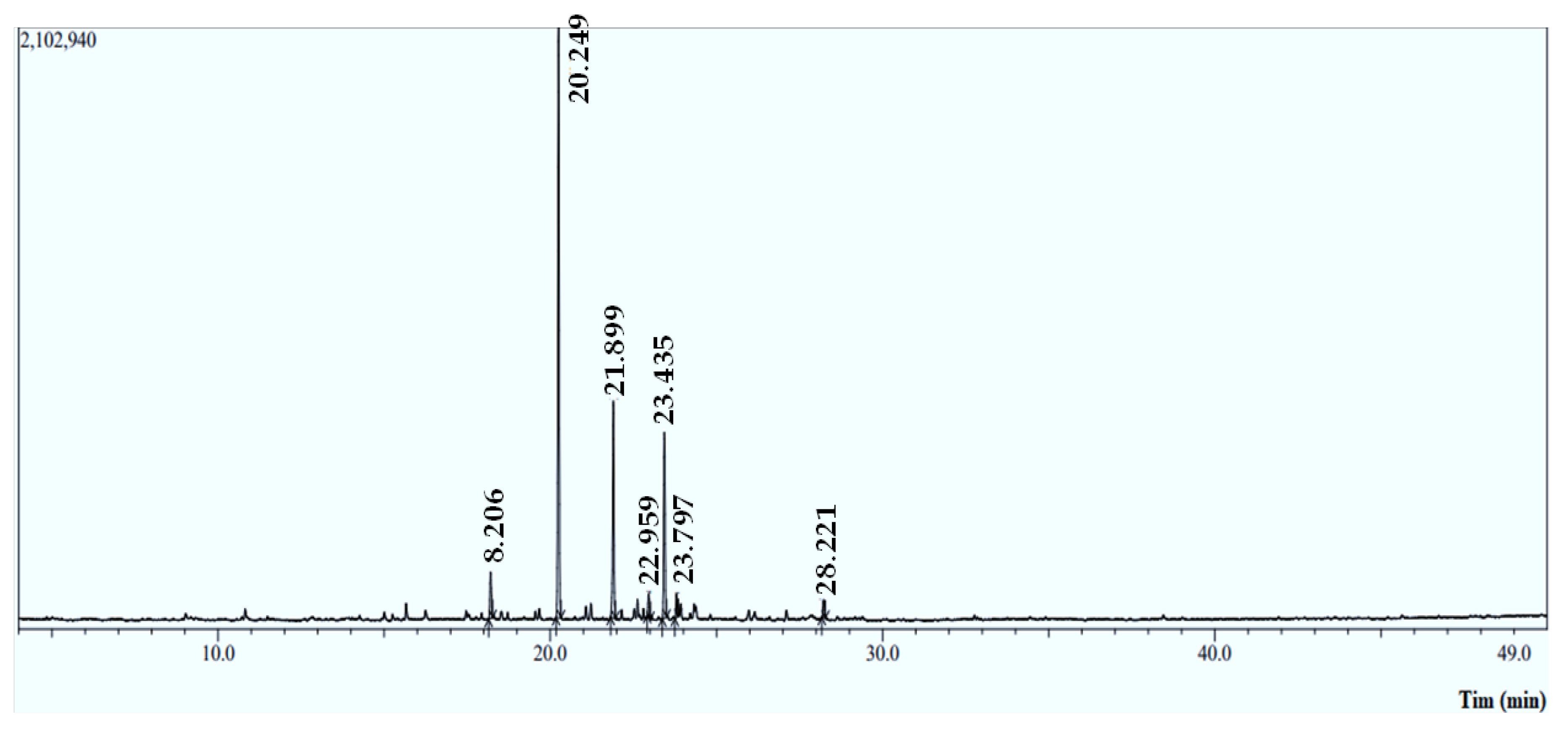

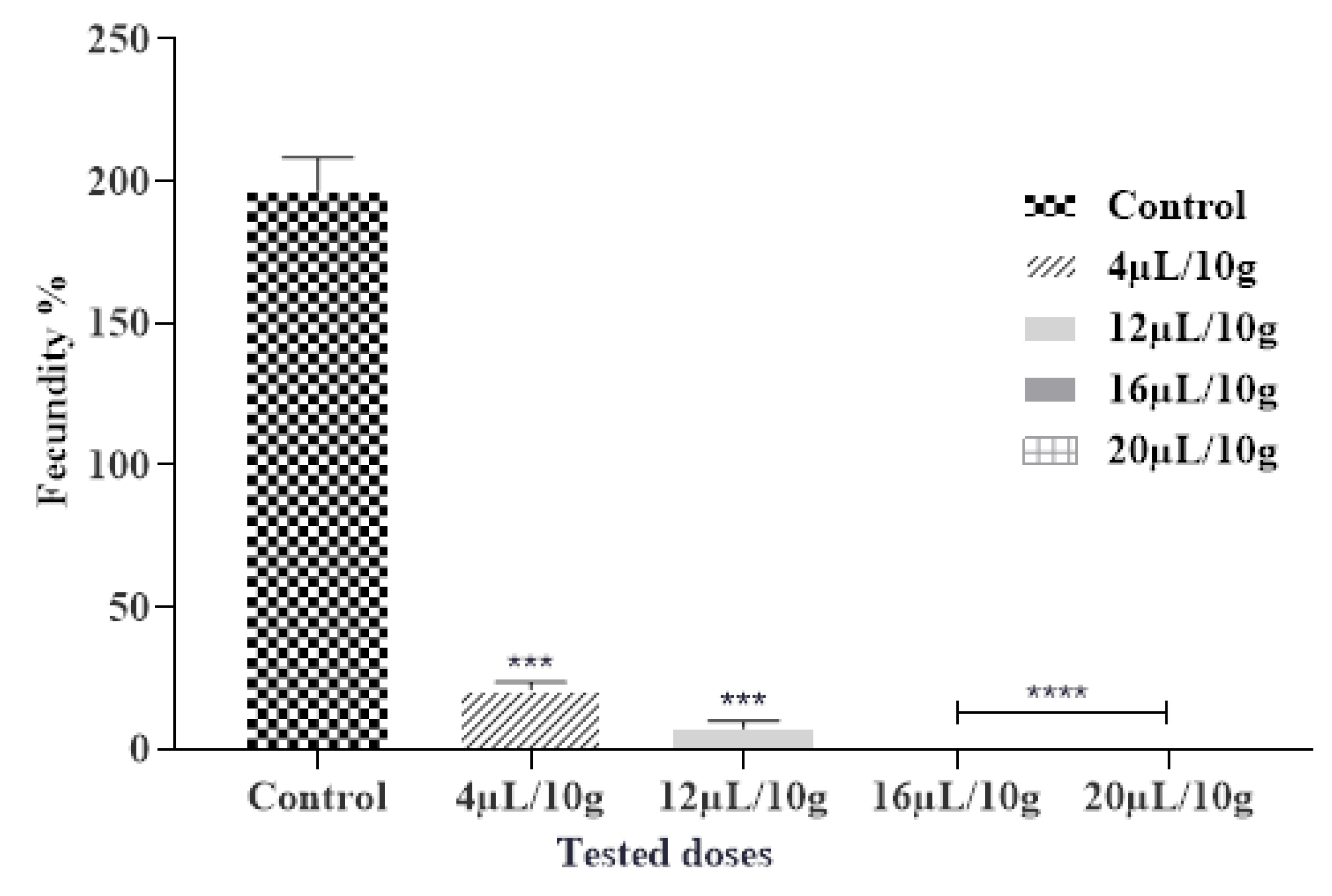
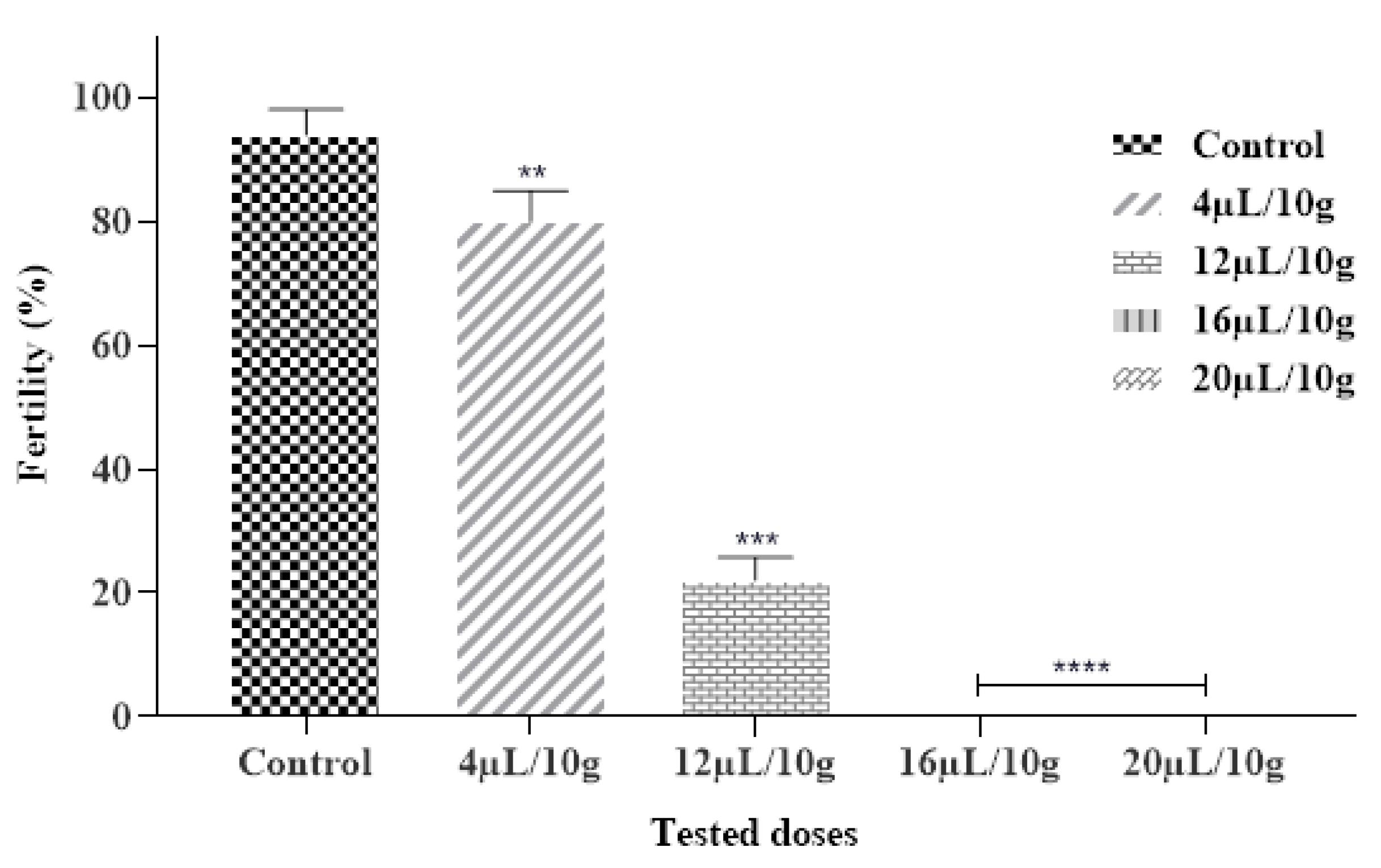
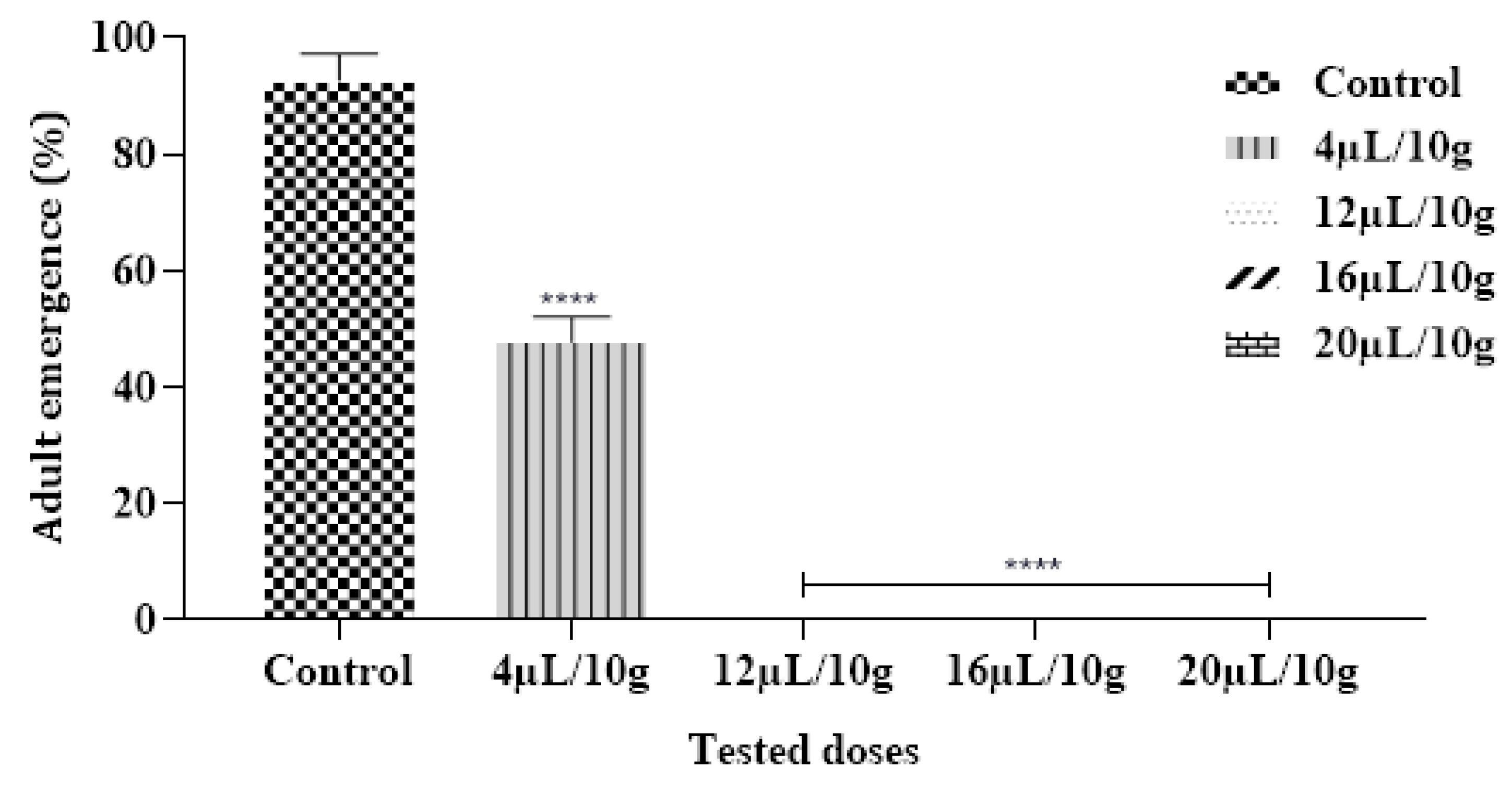
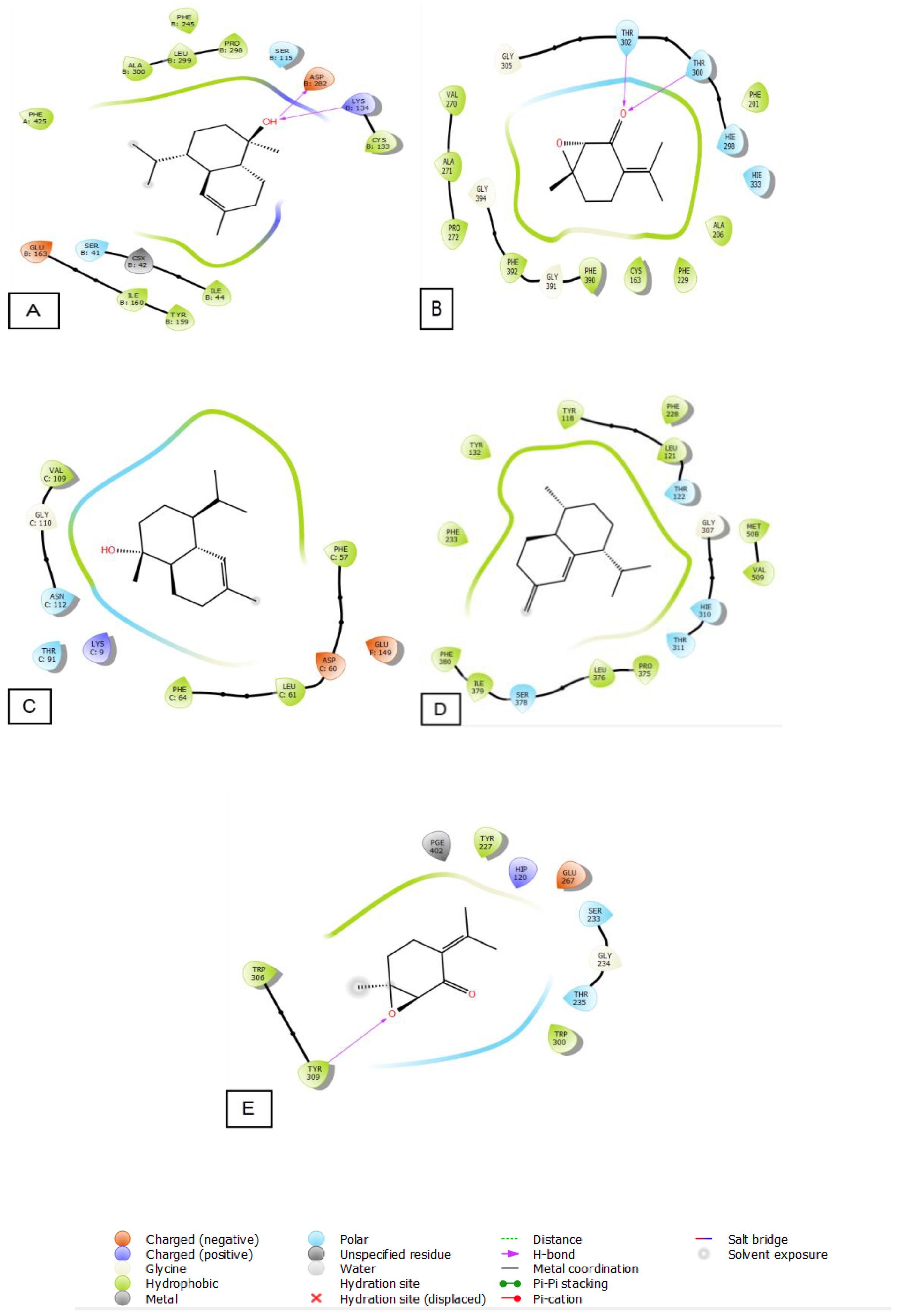


| Peak | RT (min) | Compounds | Chemical Classes | RI | Molecular Formula | Area% | |
|---|---|---|---|---|---|---|---|
| Cal | Lit | ||||||
| 1 | 18.206 | Bornyl acetate | MO | 1277 | 1286 | C12H20O2 | 4.47 |
| 2 | 20.249 | Piperitenone oxide | MO | 1236 | 1366 | C10H14O2 | 53.43 |
| 3 | 21.899 | Caryophyllene | ST | 1494 | 1432 | C15H24 | 20.02 |
| 4 | 22.959 | cis-Muurola-4(15),5-diene | ST | 1435 | 1467 | C15H24 | 1.87 |
| 5 | 23.435 | (−) Germacrene D | ST | 1515 | 1482 | C15H24 | 16.53 |
| 6 | 23.797 | Bicyclogermacrene | ST | 1499 | 1495 | C15H24 | 1.93 |
| 7 | 28.221 | α-Cadinol | ST | 1580 | 1654 | C15H26O | 1.75 |
| Chemical classes | |||||||
| Monoterpene (MO) | |||||||
| Sesquiterpene (ST) | |||||||
| Total (%) | 100.00 | ||||||
| ML-EO | BHT | TROLOX | AA | |
|---|---|---|---|---|
| DPPH IC50 (μg/mL) | 1.49 ± 0.00 a | 42 ± 0.01 b | - | - |
| ABTS IC50 (μg/mL) | 0.051 ± 0.06 a | - | 24.14 ± 0.19 b | - |
| RP EC50 (μg/mL) | 0.80 ± 0.01 a | - | - | 31 ± 0.07 b |
| TAC (mg/mL) | 315.53 ± 0.01 | - | - | - |
| Simple | Gram-Negative Bacteria | Gram-Positive Bacteria | |||
|---|---|---|---|---|---|
| P. aeruginosa | E. coli | S. aureus | B. subtilis | ||
| Essential oil | Antibacterial activity (mm) | 24.50 ± 0.71 | 7.55 ± 0.64 | 7.50 ± 0.71 | 16.00 ± 1.41 |
| MIC (µg/mL) | 0.005 ± 0.00 | 0.010 ± 0.00 | 0.011 ± 0.00 | 0.015 ± 0.00 | |
| Streptomycin | Antibacterial activity (mm) | 6 ± 0.00 (R) | 6 ± 0.00 (R) | 11 ± 0.01 | R |
| MIC (µg/mL) | - | - | 1.55 ± 0.00 | - | |
| Erythromycin | Antibacterial activity (mm) | 6 ± 0.00 (R) | 6 ± 0.00 (R) | 6 ± 0.00 (R) | 6 ± 0.00 (R) |
| MIC (µg/mL) | - | - | - | - | |
| DMSO (10%) | Antibacterial activity (mm) | 6 ± 0.00 (R) | 6 ± 0.00 (R) | 6 ± 0.00 (R) | 6 ± 0.00 (R) |
| Simple | Antifungal Activity by Disc Method (mm) | Antifungal Activity by the Microdilution Method (MIC in mg/mL) | ||
|---|---|---|---|---|
| Candida albicans | Aspergillus niger (%) | Candida albicans | Aspergillus niger | |
| Essential oil | 20.00 ± 0.01 | 1.50 ± 0.02 | 0.005 ± 0.00 | 0.005 ± 0.00 |
| Fluconazole | 6 ± 0.00 (R) | 8.25± 1.02 | - | 7.15 ± 0.01 |
| DMSO | 6 ± 0.00 (R) | 6 ± 0.00 (R) | 6 ± 0.00 (R) | 6 ± 0.00 (R) |
| Essential Oil | Doses of EO (µL/L of Air/10 g) | Exposure Time (Hours) | ||||
|---|---|---|---|---|---|---|
| 3 h | 6 h | 12 h | 18 h | 24 h | ||
| ML-EO | Control | 0 ± 0.00 | 0 ± 0 | 0 ± 0 | 0 ± 0 | 0 ± 0 |
| 4 | 0 ± 0.00 | 44.66 ± 9.23 | 66.66 ± 2.88 | 93.33 ± 7.63 | 100 ± 0 | |
| 12 | 3.33 ± 2.88 | 55 ± 10 | 71.66 ± 5.77 | 95 ± 8.66 | 100 ± 0 | |
| 16 | 11.66 ± 7.63 | 61.66 ± 2.88 | 86.66 ± 8.00 | 100 ± 0.00 | 100 ± 0 | |
| 20 | 28.33 ± 5.77 | 63.33 ± 8.66 | 91.66 ± 2.33 | 100 ± 0.00 | 100 ± 0.00 | |
| Treatment (h) | LC50 (μL/L) | 95% CI | LC90 (μL/L) | 95%CI | df | χ2 | |
|---|---|---|---|---|---|---|---|
| ML-EO | 3 | 29.42 | 19.96–309.41 | 73.09 | 34.92–13,080.778 | 2 | 0.098 |
| 6 | 5.62 | - | 18.74 | - | 2 | ||
| 12 | 2.24 | 0.0–4.68 | 18.71 | 10.52–139,889.51 | 2 | 0.624 | |
| 18 | 0.75 | - | 3.47 | - | 2 | 0.914 | |
| 24 | - | - | - | - | - | - |
| Dose (μL/L Air) | Fecundity | Fertility (%) | Adult Emergence (%) |
|---|---|---|---|
| ML-EO | ML-EO | ML-EO | |
| 4 µL | 21 ± 2.65 | 80 ± 5 | 47.82 ± 4.18 |
| 12 µL | 7.34 ±2.51 | 22.11± 3.64 | 0 ± 0 |
| 16 µL | 0 ± 0 | 0 ± 0 | 0 ± 0 |
| 20 µL | 0 ± 0 | 0 ± 0 | 0 ± 0 |
| Control | 196.67 ± 11.55 | 94.02 ± 11.55 | 93.35 ± 5.20 |
| Dose (μL/cm2) | RI (Mean ± SD) | Repellency Class | The Average Rate of Repulsively (%) |
|---|---|---|---|
| ML-EO | ML-EO | ||
| 4 | 77 ± 5.00 | Repellent | 89.75 |
| 12 | 90 ± 8.16 | Repellent | |
| 16 | 92 ± 5.00 | Repellent | |
| 20 | 100 ± 0.00 | Repellent |
| Antioxidant Activity | Antibacterial Activity | Antifungal Activity | |||
|---|---|---|---|---|---|
| Title | 2CDU | 1FJ4 | 3Q8U | 5FSA | 5I77 |
| Glide Gscore (Kcal/mol) | |||||
| (−) Germacrene D | −5.085 | −5.998 | −4.128 | −6.825 | −4.054 |
| α-Cadinol | −6.041 | −5.467 | −5.714 | −7.182 | −4.377 |
| Bicyclogermacrene | −4.576 | −5.369 | −4.211 | −7.085 | −4.187 |
| Bornyl acetate | −3.585 | −5.436 | −3.389 | −5.497 | −4.022 |
| Caryophyllene | −3.948 | −5.064 | −4.157 | −7.025 | −3.582 |
| cis-Muurola-4(15), 5-diene | −4.811 | −6.321 | −4.867 | −7.486 | −3.908 |
| Piperitenone oxide | −5.195 | −7.104 | −4.771 | −5.606 | −4.687 |
Disclaimer/Publisher’s Note: The statements, opinions and data contained in all publications are solely those of the individual author(s) and contributor(s) and not of MDPI and/or the editor(s). MDPI and/or the editor(s) disclaim responsibility for any injury to people or property resulting from any ideas, methods, instructions or products referred to in the content. |
© 2023 by the authors. Licensee MDPI, Basel, Switzerland. This article is an open access article distributed under the terms and conditions of the Creative Commons Attribution (CC BY) license (https://creativecommons.org/licenses/by/4.0/).
Share and Cite
Tourabi, M.; Nouioura, G.; Touijer, H.; Baghouz, A.; El Ghouizi, A.; Chebaibi, M.; Bakour, M.; Ousaaid, D.; Almaary, K.S.; Nafidi, H.-A.; et al. Antioxidant, Antimicrobial, and Insecticidal Properties of Chemically Characterized Essential Oils Extracted from Mentha longifolia: In Vitro and In Silico Analysis. Plants 2023, 12, 3783. https://doi.org/10.3390/plants12213783
Tourabi M, Nouioura G, Touijer H, Baghouz A, El Ghouizi A, Chebaibi M, Bakour M, Ousaaid D, Almaary KS, Nafidi H-A, et al. Antioxidant, Antimicrobial, and Insecticidal Properties of Chemically Characterized Essential Oils Extracted from Mentha longifolia: In Vitro and In Silico Analysis. Plants. 2023; 12(21):3783. https://doi.org/10.3390/plants12213783
Chicago/Turabian StyleTourabi, Meryem, Ghizlane Nouioura, Hanane Touijer, Asmae Baghouz, Asmae El Ghouizi, Mohamed Chebaibi, Meryem Bakour, Driss Ousaaid, Khalid S. Almaary, Hiba-Allah Nafidi, and et al. 2023. "Antioxidant, Antimicrobial, and Insecticidal Properties of Chemically Characterized Essential Oils Extracted from Mentha longifolia: In Vitro and In Silico Analysis" Plants 12, no. 21: 3783. https://doi.org/10.3390/plants12213783
APA StyleTourabi, M., Nouioura, G., Touijer, H., Baghouz, A., El Ghouizi, A., Chebaibi, M., Bakour, M., Ousaaid, D., Almaary, K. S., Nafidi, H.-A., Bourhia, M., Farid, K., Lyoussi, B., & Derwich, E. (2023). Antioxidant, Antimicrobial, and Insecticidal Properties of Chemically Characterized Essential Oils Extracted from Mentha longifolia: In Vitro and In Silico Analysis. Plants, 12(21), 3783. https://doi.org/10.3390/plants12213783








